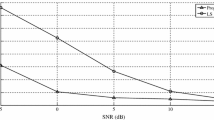Abstract
The spectral analysis of Doppler blood flow velocity signals enjoys wide-spread interest owing to the exhaustive information on the signal which it yields. The discrete Fourier transform is the most extensively used method of analysis. However, the statistical stability of such analysis is poor; spectral smoothing, which improves the statistical stability, also results in greater width and poorer resolution of the spectrum. Autoregressive modelling has been found to give better results when analysing small sample volumes obtained from a pulsed velocimeter (narrow spectrum), even for short data lengths.
Similar content being viewed by others
References
Bodily, K. C., Zierler, R. E., Greene, F. M., Blackshear, W. M., Philips, D. J., Beach, K. W. andStrandness, D. E. (1981) Spectral analysis of Doppler velocity signals in normals and patients with carotid artery stenosis.Clin Phys.,1, 365–374.
Burckhardt, C. B. (1981) Comparison between spectrum and time interval histogram of ultrasound Doppler signals.Ultrasound in Med. & Biol.,7, 79–82.
Creekmore, S. P., Graham, M. M., Jahn, G. E., Targett, R. C. andMcIlroy, M. B. (1982) Comparison of methods of recording and analysis of Doppler blood velocity signals.,8, 525–535.
Fung, Y. C. (1984)Biodynamics. Circulation. Springer.
Harris, F. J. (1978) On the use of windows for harmonic analysis with the discrete Fourier Transform.Proc. IEEE,66, 51–83.
Hollander, M. andWolfe, D. A. (1973)Nonparametric statistical methods. Wiley.
Kay, S. M. andMarple, S. L. (1981) Spectrum analysis—a modern perspective.Proc. IEEE,69, 1380–1419.
Lunt, M. (1975) Accuracy and limitations of the ultrasonic Doppler blood velocimeter and zero crossing detector.Ultrasound in Med. & Biol.,2, 1–10.
Markel, J. D. andGray, A. H. (1976)Linear prediction of speech. Springer.
Oppenheim, A. V. andSchafer, R. W. (1975)Digital signal processing. Prentice-Hall.
Owen, D. B. (1962)Handbook of statistical tables. Addison-Wesley.
Schroeder, M. R. (1984) Linear prediction, entropy and signal analysis.IEEE ASSP Mag.,1, 3–11.
Ulrych, T. J. andBishop, T. N. (1975) Maximum entropy spectral analysis and autoregressive decomposition.Rev. Geophys. Space Phys.,13, 183–200.
Author information
Authors and Affiliations
Rights and permissions
About this article
Cite this article
Kaluzynski, K. Analysis of application possibilities of autoregressive modelling to doppler blood flow signal spectral analysis. Med. Biol. Eng. Comput. 25, 373–376 (1987). https://doi.org/10.1007/BF02443356
Received:
Accepted:
Issue Date:
DOI: https://doi.org/10.1007/BF02443356




